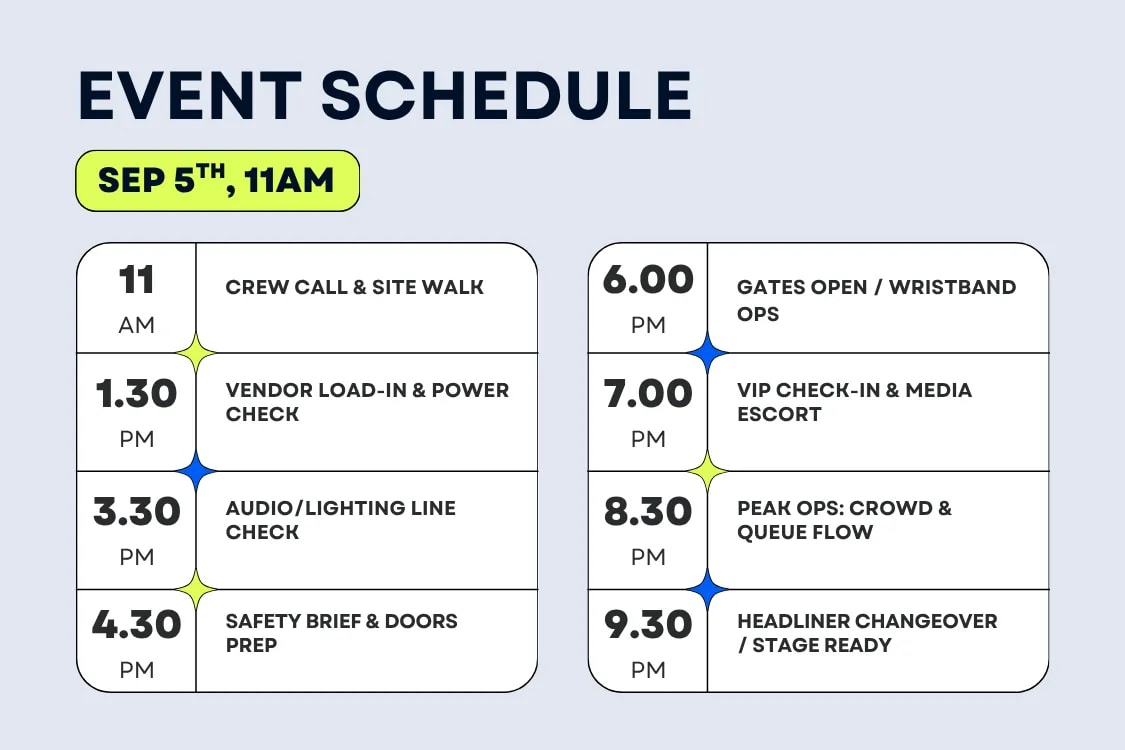
Small to mid-sized events look effortless from the outside—until you’re the person behind the curtain. Between aligning stakeholders, wrangling vendors, balancing the budget, and keeping guests safe and delighted, an event coordinator’s responsibilities stretch across strategy, logistics, and on-the-day leadership. The role is fast-paced, multifaceted, and increasingly in demand, with steady growth projected in the coming decade (U.S. outlook). The good news? With a structured playbook and the right tools, you can manage even complex programs like a pro.
This guide breaks down core event coordinator responsibilities, essential skills, recommended tech, and practical best practices—tailored to events in the 50–1,500 attendee range. You’ll find examples, checklists, and proven tactics you can apply immediately.
At its heart, the event coordinator role spans the full project lifecycle—from idea to debrief. Treating each event as a structured project keeps you aligned, on budget, and ready for curveballs. A widely adopted framework suggests moving through five stages: initiating, planning, executing, monitoring/controlling, and closing (project lifecycle).
Translate client vision into a scoped plan with goals, audience, and success metrics
Build and manage a realistic budget, with forecasts, buffers, and approvals
Source, negotiate, and coordinate vendors with clear SLAs and escalation paths
Design logistics: venue, seating, transportation, accommodations, accessibility, safety
Lead onsite execution: run-of-show, crew briefings, comms, and real-time decision-making
Close out: reconcile budget, collect feedback, document learnings, and measure ROI
The Loopyah Content Team shares expert insights, practical guides, and industry updates to help event organizers create unforgettable experiences and stay ahead in the event planning world.
planning
Treat every event like a project with defined phases and clear role ownership. This structure reduces misalignment, accelerates decisions, and protects your margin.
To keep responsibilities crystal clear, publish a simple RACI (Responsible, Accountable, Consulted, Informed) matrix early and revisit it after each major decision. It’s the fastest way to prevent last-minute tasks from falling through the cracks.
Great events start with discovery. Your job is to translate a client’s vision into a scope you can deliver. Begin by defining the “why,” the audience, and the outcomes the client cares about—registrations, engagement, sales, media, or community impact. Then convert that vision into a concrete plan:
Discovery brief: goals, KPIs, audience personas, must-haves/nice-to-haves, decision-makers
Stakeholder map: sponsors, speakers, vendors, venue, security, marketing, finance
Scope and WBS: break the event into manageable work packages with owners and dates
Timeline: align milestones (launch, ticketing, vendor cutoffs, rehearsals, show call) to avoid crunch
Budget ownership is central to event coordinator responsibilities. Costs for travel, lodging, and destination services fluctuate—so build in buffers and update forecasts as quotes turn into contracts. For corporate programs, use federal per-diem benchmarks to estimate lodging and meals in unfamiliar markets and set realistic internal caps for staff and talent. That simple guardrail helps contain reimbursements and pre-buys.
Practical budgeting moves for small to mid-sized events:
Create a top-down budget (by category) and a bottom-up budget (by line item) and reconcile the two. Differences reveal hidden assumptions.
Add 10–15% contingency to categories with volatile pricing (AV, staffing, logistics), and a separate 5–10% management reserve for unknowns.
Build a cash flow view so you’re not surprised by deposits, progress payments, and reconciliations.
Track commitments weekly. When quotes become POs, update the forecast. If savings appear, reallocate intentionally (e.g., better keynote lighting over swag).
For a step-by-step walkthrough, check our guide to building a realistic event budget—including templates and common line items you might overlook.
Vendors can make or break your event. Strong coordination starts with strategic RFPs that share goals, constraints, and definitions of success—so partners can propose creative solutions rather than just line items. For contracts, review service levels, escalation paths, response times, and price-increase caps. Confirm critical onsite roles early (TD, A1, stage manager, lead decorator, security supervisor) and set a daily check-in rhythm during show week.

Mini-case: For a 450-person industry summit, the venue’s internet provider had an exclusive. The initial quote exceeded budget by 40%. By revisiting the contract and negotiating a usage-based tier with a cap, the team saved five figures without sacrificing attendee experience.
Checklist for vendor coordination:
RFPs that define objectives, constraints, and success criteria
Contracts with SLAs, escalation paths, and reciprocal protections (force majeure, attrition windows)
Staffing maps with named leads and backup contacts
Daily huddles onsite; issue log with owners and ETAs
Logistics for small to mid-sized events are complex enough to require coordination but nimble enough that smart planning gives you big wins. Focus on four pillars: venue fit, attendee flow, accessibility, and safety.
Venue selection: Match capacity and layout to program needs. Evaluate rigging points, ceiling height, power, load-in routes, and storage. For seated events, ensure ADA-compliant ticketing and seating parity, and plan for quiet rooms and lactation spaces where appropriate.
Transportation and accommodation: Publish travel windows and shuttle schedules with clear points of contact. Use per-diem benchmarks to set staff and talent guidelines and to avoid reimbursement surprises.
Safety and weather: Decide go/no-go thresholds in advance. Train crowd managers, run radio checks, and rehearse shelter-in-place or evacuation procedures. Standardize your severe-weather protocol and mass comms templates.
Example: A 1,000-attendee outdoor festival used a simple color-coded weather plan and a scripted PA + SMS alert sequence. When lightning approached, the team calmly paused performances, instructed guests to shelter, and resumed on schedule—without panic or negative reviews.
Beyond checklists, the best coordinators excel at people leadership, organization, and rapid problem-solving. Here’s how those skills translate onsite.
Establish clear rhythms with clients, vendors, and your internal team. Replace ad hoc updates with weekly checkpoints, structured agendas, and post-meeting recaps. Keep your stakeholder register current so your message, medium, and cadence fit each audience.
Use status briefs (1 page) summarizing timeline, risks, and decisions needed this week.
Write to be skimmed: bullets, bolded deadlines, and links to source docs.
Practice constructive conflict: escalate early and focus on tradeoffs, not blame.
Case in point: A sponsor requested a last-minute stage segment. The coordinator used a simple change brief—impact to timing, rehearsal, and run-of-show—to negotiate a shorter slot that preserved breaks and AV timing. Everyone left aligned.
Context switching kills productivity. Protect deep work blocks for run-of-show builds, budget reconciliation, and contract reviews. Standardize naming conventions for files, and keep all artifacts in shared folders with version history.
Time-block focus windows daily; batch emails and chat to two windows if possible.
Use checklists for repeatable tasks (speaker comms, sponsor deliverables, show-call prep).
Track RAID (Risks, Assumptions, Issues, Dependencies) in one shared log.
Need starting templates and tools? Explore our curated event marketing tools roundup. Many of these apps double as coordination and planning aids for small to mid-sized programs.
Problems happen. Pros rehearse them in advance. Run a pre-mortem with your core team two weeks before show day: What could derail us? What early signals should we watch? Who owns the decision if it occurs? Pair that with your RACI so no one wonders who has the call when time is short.
Example: When a speaker flight was delayed, the coordinator’s decision tree kicked in—move the panel earlier, swap Q&A to the end, and offer a virtual cameo if arrival slipped past 4 PM. The audience never noticed the pivot.
Your tech stack should cut coordination costs and surface insights—not add busywork. For small to mid-sized events, consolidate around a core event platform, a collaboration suite, and a few mobile helpers for field decisions and attendee entry.
Look for an event platform that spans ticketing, registration, seating, marketing, analytics, and onsite operations. Strong integrations save time and reduce errors. If your events use reserved seating, interactive seat maps help you optimize inventory, honor ADA requirements, and smooth the check-in experience.
Curious what a unified platform looks like? Explore Loopyah’s event software features—built to streamline planning and sellouts for in-person and hybrid programs.
Bonus: If you plan to sell reserved seats, our interactive mapping supports efficient layouts and sightline-aware pricing. It’s a small tweak that pays off in higher yield and happier guests.
Real-time co-authoring, task boards, and integrated chat keep your team synchronized through the final week. Use one shared calendar for rehearsals, load-in/out, and crew call times. Keep decisions in documented threads (not DMs) to preserve context and reduce repeat questions.
Docs and sheets: real-time editing for run-of-show, budget, and vendor contact sheets
Boards: Kanban or list views for tasks, dependencies, and day-by-day show ops
Chat: dedicated channels for AV, registration, green room, security, and client approvals
Equip field teams with mobile essentials: secure document access, group chat, and alerting. For safety, use a reliable weather app and standardize severe-weather protocols. For entry, support mobile wallets and QR passes to reduce queues and headaches at gate.
Tip: If your crew spans multiple locations (main stage, breakouts, loading dock), set up channel-based comms and define triage rules. Use short, consistent radio codes and keep the airwaves clear of non-essentials during show calls.

These practices turn good intentions into reliable execution. Use them to reduce stress and consistently deliver high-quality experiences.
Build a single, integrated plan that ties scope, schedule, budget, risk, and communications together. Keep it living—update baselines after each major decision so reality matches the documents your team is using.
Run-of-show: cues, owners, comms channel, and timing for every segment
RAID log: risks, assumptions, issues, and dependencies with owners and due dates
RACI matrix: clarify who’s Responsible vs. Accountable; publish it and keep it current
Start with our comprehensive event planning checklist and adapt it to your program size and complexity.
Match the message to the audience. Executives need KPIs and decisions; vendors need specs, deadlines, and load-in details; attendees need concise wayfinding and schedule info. Document SLAs with vendors (response times, escalation paths) so everyone knows how to resolve issues fast.
Example: For a 300-person nonprofit gala, the coordinator set a two-business-hour SLA for vendor replies during show week. When a linen shipment was delayed, the venue and caterer followed the escalation path to secure alternates within 90 minutes—kept costs flat and avoided panic.
Batch your work and centralize your information. Use a master folder with standard naming (YYYYMMDD_EventName_DocumentType). Schedule recurring focus blocks for deep work (budget, contracts, ROS), and hold short daily standups during show week.
Marketing and sales alignment also matter for small to mid-sized events. If your goal is a sellout, coordinate timelines with your ticketing and promotional plan. For tactics that convert, see our guide on event marketing tools and our tips to sell more tickets without discounting away your margins.
Scenario 1—AV surprise: Your keynote adds a live demo requiring an extra camera and switcher day-of. Because your contract included an on-call addendum with capped hourly rates and pre-approved labor tiers, you add resources without blowing the budget or waiting on finance.
Scenario 2—Accessibility-first seating: Your 600-seat theater sells quickly, and you need to expand companion seating. With an interactive seat map and clearly labeled accessible inventory, you reallocate sections in minutes, maintain parity, and update ticketing comms before doors.
Scenario 3—Weather window: A pop-up street festival faces a 50% chance of thunderstorms. You’ve defined go/no-go thresholds, pre-written attendee messages, and set up a group text for vendors. When radar shifts, you delay opening by 30 minutes, push a friendly update, and keep the vibe intact.
Use this quick-hit sequence to kick off any small to mid-sized event and stay in control.
Align on outcomes: Define 3–5 measurable success metrics (attendance, NPS, revenue, content captures).
Map stakeholders: Identify decision-makers and influencers; set update cadences and escalation paths.
Build the plan: WBS, timeline, budget with contingency, and a shared RAID log.
Source vendors: Strategic RFPs, apples-to-apples comparisons, and contract protections (force majeure, attrition, AV/internet/electric exclusives).
Design attendee flow: registration, wayfinding, seating, accessibility, F&B, and dwell times.
Rehearse the pivots: Pre-mortem top risks; define triggers and owners for go/no-go calls.
Run the show: Daily crew briefings, issue log with ETAs, and calm, consistent comms.
Close and learn: Reconcile budget, collect feedback, measure against KPIs, and document improvements for next time.
And if you’re ready to streamline the operational side—from seating to email outreach—consider consolidating your stack with a modern, integrated platform. You’ll save hours each week and gain clearer visibility into sales and show-readiness.
Event coordinator responsibilities cover the entire lifecycle: clarifying outcomes, planning, budgeting, coordinating vendors, managing logistics, and making smart calls when the unexpected happens. The coordinators who consistently win treat events like disciplined projects, codify expectations with vendors, and lean on integrated tech—without ever compromising on safety, accessibility, or stakeholder experience.
Whether you’re producing a 100-person client summit or a 1,200-attendee festival, professionalize your process, measure what matters, and iterate after every event. The payoff isn’t just smooth show days—it’s stronger ROI, happier stakeholders, and a reputation for reliability that grows your career.
Industry outlook note: Demand for skilled coordinators remains steady as live experiences continue to fuel community and business outcomes (career snapshot). Embrace the challenge—it’s one of the most rewarding jobs in the experience economy.
planning
planning
planning
planning
planning
planning
planning
planning
planning